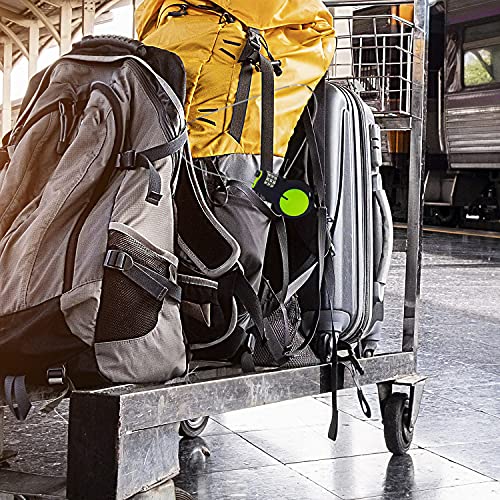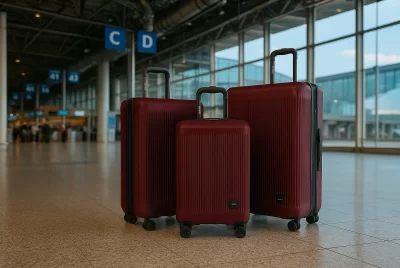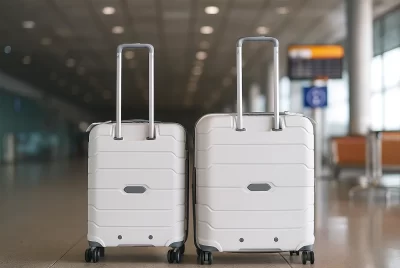TSA Locks and Luggage Security: Complete Guide
*We may earn a commission for purchases made using our links. Please see our disclaimer to learn more.
Imagine standing at the baggage claim, watching the carousel turn endlessly while your suitcase remains nowhere to be found. Or worse, retrieving your luggage only to discover it’s been tampered with, your belongings rifled through or missing entirely. These scenarios highlight a critical aspect of travel that many overlook: luggage security.
The reality is that thousands of bags are lost, stolen, or damaged every day in airports worldwide. While travelers often focus on booking flights and planning itineraries, the security of their belongings during transit receives far less attention. Yet understanding how luggage security works—from TSA locks to zipper mechanisms and security seals—can mean the difference between a smooth journey and a travel nightmare.
Modern luggage security represents a fascinating intersection of convenience, compliance, and protection. The Transportation Security Administration (TSA) has fundamentally changed how we secure our belongings while traveling, creating systems that allow security personnel to inspect bags without destroying locks or causing damage. This evolution has spawned an entire ecosystem of security products designed to protect your valuables while maintaining compliance with aviation regulations.
“The key to effective luggage security lies not in making your bag impenetrable, but in making it more difficult to tamper with than the bag next to it.”
– Travel Security Expert, International Air Transport Association
Key Takeaways
- TSA locks provide authorized access: These specialized locks allow security personnel to open and inspect your luggage without cutting locks or damaging zippers
- Multiple security layers work best: Combining TSA locks, quality zippers, and security seals creates comprehensive protection against tampering
- Proper zipper selection matters: Heavy-duty zippers with reinforced stitching offer better resistance to forced entry than standard lightweight options
- Security seals detect tampering: Tamper-evident seals provide visual confirmation if your luggage has been opened during transit
- Compliance ensures smooth travel: Understanding TSA regulations prevents delays and potential damage to your luggage during security screening
Recommended Luggage Security Products
1. Master Lock 4688D TSA Approved Cable Luggage Lock
Secure your belongings with confidence using the Master Lock 4688D, a TSA-approved combination lock designed to enhance your luggage security during air travel. This 4-pack set is perfect for travelers managing multiple bags. With a flexible cable shackle and sturdy metal body, these locks offer durability and ease of use. The three-digit combination allows quick access while keeping unauthorized hands out, and TSA agents can inspect bags without breaking the lock—ensuring both security and compliance.
For travelers looking to improve their luggage security, the Master Lock 4688D offers a reliable, TSA-compliant solution. These compact cable locks feature a three-digit combination mechanism that keeps bags secure while still allowing TSA agents to inspect them without damage. Built from durable metal and sold in a convenient 4-pack, they’re ideal for protecting multiple pieces of luggage on longer trips or group travel. The flexible cable makes it easy to thread through various zipper types, helping ensure peace of mind no matter where your journey takes you.
- TSA Compliance: Easily passes through airport security without damage to the lock.
- Multipack Value: Ideal for securing several pieces of luggage in one trip.
- Durability: Sturdy metal build resists tampering and long-term wear.
- Color Variability: Colors are randomly shipped, so you can't choose your preferred color.
- Resetting Difficulty: Some users report challenges when resetting combinations.
- Cable Looseness: Cable may feel slightly loose on smaller zippers or handles.
2. Lewis N. Clark TSA Approved Retractable Cable Luggage Lock
Upgrade your luggage security with the Lewis N. Clark TSA-Approved Retractable Cable Lock. Featuring a durable 30-inch braided steel cable and a 3-digit combination lock, this versatile travel essential helps secure your belongings on the go. The retractable cable lets you fasten multiple items together—ideal for bags, gear, or even bikes. Built with sturdy thermoplastic rubber and ABS casing, this compact lock offers flexibility and peace of mind whether you're at the airport, hotel, or campsite.
When it comes to enhancing luggage security, flexibility matters—and the Lewis N. Clark TSA-approved cable lock delivers just that. With its retractable 30-inch steel cable, travelers can lock multiple bags or secure their belongings to fixed objects like poles or luggage racks. The resettable combination eliminates the need for keys, making it convenient and reliable during transit. Whether you’re flying internationally or storing items at home or a hostel, this lock provides both function and peace of mind in a compact, travel-friendly design.
- Versatile Cable Length: 30-inch retractable cable can secure multiple bags or gear at once.
- No Key Needed: Set your own combination—no small keys to lose during travel.
- Multi-Use Functionality: Great for luggage, bikes, cabinets, or temporary setups.
- Bulky for Small Zippers: May be too large for compact or delicate luggage zippers.
- Cable Retraction Issues: Cable may not retract smoothly if twisted or tangled.
- Plastic Build: While durable, the plastic casing may not feel as strong as full-metal locks.
3. Forge TSA Approved Cable Luggage Locks
Boost your luggage security with the ultra-durable Forge TSA Approved Cable Locks. Engineered with a solid alloy steel body, braided steel cables, and a patented internal mechanism, these locks are built to withstand rough handling and secure your belongings through every leg of your journey. The 3-digit resettable combination is easy to configure, while the TSA-compliant design ensures that airport agents can inspect your bag without leaving it unlocked. Compact, tough, and flexible—these locks are ideal for securing suitcases, gun cases, backpacks, and more.
When travelers look for maximum luggage security, Forge TSA-approved cable locks stand out as a durable and flexible option. These locks are crafted with alloy steel and feature tightly braided cables that are strong enough to resist tampering while being thin enough to thread through most zipper pulls and case locks. What sets them apart is the unique re-locking mechanism—ensuring that TSA agents must relock the bag after inspection. Whether you’re securing a suitcase, gun case, or backpack, Forge locks offer long-term peace of mind with a lifetime guarantee to back it up.
- Maximum Durability: Built from alloy steel with a reinforced cable and internal components.
- Re-lock Guarantee: TSA agents must re-lock your bag after inspection, keeping contents secure.
- Flexible Fit: Cable easily threads through zippers, lock holes, and hard-case openings.
- Stiff Cable: Braided cable may be harder to maneuver around tight zipper areas.
- Initial Setup Confusion: Some users may find setting the combination tricky at first.
- Slightly Larger Profile: May not fit smaller or minimalist travel bags neatly.
4. Forge TSA Approved Luggage Lock with 15″ Extra-Long Cable
Enhance your luggage security with the Forge TSA-Approved Key Lock, designed for travelers who need flexibility, strength, and top-tier protection. Featuring a 15-inch extra-long steel cable, this lock can secure multiple bags or bulky equipment like rifle cases, golf bags, or hard-shell trunks. The advanced dimple key system and zinc alloy body offer superior resistance to tampering and lock picking. TSA compliance ensures airport agents can inspect and re-lock your bag without damage—giving you peace of mind wherever you travel.
If you’re looking for a serious upgrade in luggage security, the Forge TSA-approved cable key lock is a strong contender—especially for travelers carrying multiple or oversized items. Its 15-inch steel cable allows for flexible and secure locking of gear, from suitcases and backpacks to golf bags and equipment cases. The advanced dimple key system offers improved protection against lock picking, while TSA approval means agents can inspect your bag without compromising your setup. Ideal for international and domestic travel, this lock adds both security and convenience to your packing strategy.
- Maximum Reach: 15" cable lets you secure multiple items or large equipment with ease.
- Advanced Security: Dimple key system offers greater resistance to picking and freezing.
- Keyed Alike: All locks use the same key, reducing bulk and making travel simpler.
- Key Required: Unlike combo locks, losing the key can lock you out of your own gear.
- Bulky for Minimalist Bags: Longer cable may be excessive for compact or single-luggage setups.
- Not Combination-Based: Travelers preferring keyless convenience may find it less practical.
Understanding TSA Lock Technology
The Transportation Security Administration revolutionized luggage security in 2003 by introducing the Travel Sentry and Safe Skies programs. These initiatives created a standardized system where approved locks could be opened by security personnel using master keys, eliminating the need to cut locks during baggage screening.
TSA locks feature a distinctive diamond-shaped logo that identifies them as approved devices. Inside each lock, a secondary locking mechanism responds to master keys held by security agencies worldwide. This dual-key system allows travelers to secure their belongings while ensuring that security personnel can access bags when necessary for inspection.
The technology behind TSA locks involves precision engineering. Each lock contains two separate locking mechanisms that operate independently. The primary mechanism responds to the user’s combination or key, while the secondary mechanism engages with the master key system. This design ensures that even if a traveler forgets their combination, security personnel can still access the bag without causing damage.
Modern TSA locks incorporate several security features beyond basic locking mechanisms. Many models include tamper-evident indicators that show if the lock has been opened during transit. Some advanced versions feature time-delay mechanisms that record when the lock was accessed, providing additional security information to travelers.
The effectiveness of TSA locks extends beyond airport security. These devices provide protection in hotels, hostels, and other accommodations where bags might be left unattended. The visual deterrent effect often proves more valuable than the physical security, as opportunistic thieves typically target easier alternatives.
The Science of Zipper Security
Zippers represent the most vulnerable point in most luggage designs, yet they’re often overlooked in security discussions. Understanding zipper construction and vulnerabilities helps travelers make informed decisions about luggage selection and additional security measures.
Standard luggage zippers consist of two fabric tapes with interlocking teeth, secured by a slider mechanism. The security level depends heavily on the zipper’s construction quality, tooth material, and tape reinforcement. Heavy-duty zippers use metal teeth or reinforced plastic components that resist forced separation better than lightweight alternatives.
The zipper’s greatest vulnerability lies in the fabric tapes that hold the teeth. A sharp object can easily penetrate these tapes, creating an opening that bypasses the zipper entirely. This vulnerability explains why some travelers prefer hard-shell luggage with integrated locking mechanisms over soft-sided bags with exposed zippers.
Zipper security can be enhanced through several methods. Zipper guards—plastic or metal strips that cover the zipper area—provide physical protection against penetration attempts. Some manufacturers integrate these guards into the luggage design, while aftermarket options can be added to existing bags.
The slider mechanism itself presents another security consideration. Quality sliders incorporate locking features that prevent unauthorized movement, while cheaper alternatives can be easily manipulated. Some travelers use small padlocks or cable ties to secure slider positions, though this approach has limitations in terms of TSA compliance.
Double-zipper systems offer improved security by requiring manipulation of two separate mechanisms. These designs also provide redundancy—if one zipper fails, the second maintains bag closure. However, double zippers also create additional points of potential failure and may complicate security screening processes.
Security Seals: The Tamper-Evident Solution
Security seals provide an often-overlooked layer of luggage protection that focuses on detection rather than prevention. These devices create visible evidence of tampering, allowing travelers to immediately identify if their bags have been opened during transit.
Traditional security seals use plastic or metal construction with unique identification numbers. Once applied, these seals cannot be removed without visible damage, creating a clear indicator of unauthorized access. The psychological effect of security seals often proves as valuable as their physical protection, as potential thieves may avoid sealed bags in favor of easier targets.
Modern tamper-evident seals incorporate advanced features like color-changing materials, sequential numbering, and even electronic components. Some electronic seals can transmit opening notifications to smartphone apps, providing real-time security updates throughout the journey.
The application of security seals requires careful consideration of luggage design and travel requirements. Seals must be positioned to prevent zipper manipulation while remaining accessible for authorized inspection. Some travelers apply multiple seals to different zipper areas, creating comprehensive tamper detection coverage.
Security seals work best when combined with other protective measures. A bag secured with TSA locks and protected by tamper-evident seals creates multiple layers of security that address different threat scenarios. This layered approach significantly improves overall luggage protection while maintaining compliance with travel regulations.
Comprehensive Security Strategies
Effective luggage security extends beyond individual devices to encompass comprehensive protection strategies. The most successful approaches combine multiple security elements while considering the specific risks and requirements of different travel scenarios.
The foundation of any security strategy involves selecting appropriate luggage. Hard-shell cases with integrated locking mechanisms offer superior protection against forced entry, while soft-sided bags provide flexibility and weight advantages. The choice depends on travel type, destination security levels, and personal preferences.
Packing strategies significantly impact security effectiveness. Distributing valuable items across multiple bags reduces the impact of any single security breach. Keeping essential items in carry-on luggage eliminates the risks associated with checked baggage handling. Some travelers use decoy techniques, placing less valuable items in easily accessible locations while hiding important belongings in concealed compartments.
Technology integration represents a growing trend in luggage security. Smart locks with Bluetooth connectivity allow remote monitoring and control, while GPS tracking devices enable real-time location monitoring. These technologies provide additional security layers but require careful consideration of battery life and connectivity requirements.
The human element remains crucial in luggage security. Maintaining awareness of your surroundings, securing bags during transit, and promptly reporting suspicious activity contribute significantly to overall protection. Many security breaches result from opportunity rather than sophisticated planning, making basic vigilance highly effective.
Airport-Specific Security Considerations
Airport environments present unique security challenges that require specialized approaches. The complexity of modern airports, combined with high passenger volumes and multiple handling points, creates numerous opportunities for luggage tampering or theft.
Baggage handling systems involve multiple transfer points where bags remain unattended for extended periods. Understanding these processes helps travelers identify vulnerability windows and implement appropriate protective measures. Some airports provide tracking systems that allow passengers to monitor their bags’ progress through the handling system.
Security screening procedures vary significantly between airports and countries. While TSA locks work effectively in most major airports, some facilities may use different systems or procedures. Researching destination-specific requirements prevents security complications and potential damage to luggage or locks.
Transit connections present particular security risks as bags may be transferred between airlines or handling systems. International connections often involve additional security screening that may require lock removal or replacement. Some travelers use disposable security seals for these situations, accepting that the seals may be broken during legitimate security procedures.
Airport layout and design influence luggage security strategies. Open baggage claim areas with minimal supervision create opportunities for theft, while secure facilities with controlled access provide better protection. Understanding your departure and arrival airports helps inform appropriate security measures.
International Travel Implications
International travel introduces additional complexity to luggage security as different countries maintain varying regulations and procedures. What works effectively for domestic travel may prove inadequate or even problematic when crossing international borders.
Customs regulations significantly impact luggage security approaches. Some countries prohibit certain types of locks or security devices, while others require specific documentation for electronic security equipment. Researching destination requirements prevents complications and potential confiscation of security devices.
Cultural considerations affect luggage security strategies in different regions. Countries with higher crime rates may require more robust security measures, while destinations with strict security protocols may limit acceptable devices. Local customs and travel advisories provide valuable guidance for appropriate security levels.
Currency and documentation security requires special attention during international travel. Many travelers use hidden compartments or specialized security pouches to protect passports, cash, and important documents. These items often prove more valuable than replaceable personal belongings and justify additional protective measures.
Language barriers can complicate security procedures in international airports. Having security device documentation in local languages helps facilitate screening processes and reduces the risk of misunderstandings that could result in device confiscation or damage.
Maintenance and Longevity
Proper maintenance extends the life and effectiveness of luggage security devices while ensuring reliable performance during critical travel situations. Regular inspection and care prevent failures that could compromise security or cause travel delays.
TSA locks require periodic maintenance to ensure smooth operation. Combination locks benefit from regular lubrication of moving parts, while key-operated models need protection from corrosion and wear. Testing locks before each trip identifies potential problems while they can still be addressed.
Zipper maintenance significantly impacts overall luggage security. Regular cleaning removes dirt and debris that can cause zipper failures, while lubrication ensures smooth operation. Damaged zippers should be repaired promptly as they create security vulnerabilities that can be exploited by potential thieves.
Security seals have limited lifespans and must be replaced regularly. Storing spare seals ensures availability when needed, while proper disposal of used seals prevents potential security compromises. Some travelers maintain logs of seal usage to track replacement schedules.
Environmental factors affect security device performance. Extreme temperatures, humidity, and exposure to chemicals can degrade materials and mechanisms. Protecting devices from harsh conditions extends their operational life and maintains security effectiveness.
Future Trends in Luggage Security
The luggage security industry continues evolving with technological advances and changing travel patterns. Understanding emerging trends helps travelers make informed decisions about security investments and strategies.
Biometric integration represents a significant development in luggage security. Fingerprint-activated locks eliminate the need for combinations or keys while providing personalized access control. Some manufacturers are exploring facial recognition and other biometric technologies for enhanced security.
Internet of Things (IoT) connectivity enables real-time monitoring and control of luggage security systems. Smart locks can send notifications when opened, track location changes, and even provide remote access for authorized personnel. These capabilities require careful consideration of privacy and security implications.
Artificial intelligence applications in luggage security include predictive analytics that assess risk levels based on travel patterns and destination characteristics. These systems can recommend appropriate security measures and alert travelers to potential threats or vulnerabilities.
Sustainable materials and manufacturing processes are becoming increasingly important in security device design. Travelers are seeking environmentally responsible options that maintain security effectiveness while reducing environmental impact. This trend is driving innovation in materials science and manufacturing techniques.
Conclusion
Luggage security represents a critical but often overlooked aspect of travel planning. The combination of TSA locks, quality zippers, and security seals creates comprehensive protection that addresses multiple threat scenarios while maintaining compliance with aviation regulations.
The key to effective luggage security lies in understanding that no single solution provides complete protection. Instead, layered approaches that combine multiple security elements with appropriate travel strategies offer the best protection for valuable belongings. This comprehensive approach requires careful consideration of specific travel requirements, destination characteristics, and personal risk tolerance.
As travel patterns continue evolving and new technologies emerge, luggage security solutions will undoubtedly advance. However, the fundamental principles of layered protection, regulatory compliance, and practical implementation will remain constant. Travelers who invest time in understanding these principles and selecting appropriate security measures will enjoy greater peace of mind and more secure travel experiences.
The investment in quality luggage security pays dividends beyond simple theft prevention. The confidence that comes from knowing your belongings are properly protected allows you to focus on the true purpose of travel—exploring new destinations, creating memories, and enjoying the journey itself.
Frequently Asked Questions
Q: Are TSA locks really effective, or can they be easily bypassed?
A: TSA locks provide a reasonable level of security for most travel situations. While they can be bypassed with sufficient time and tools, they serve as an effective deterrent against opportunistic theft. The primary value lies in their ability to be opened by security personnel without damage, preventing the need to cut locks during baggage screening. For valuable items, consider additional security measures like carrying important belongings in carry-on luggage.
Q: What should I do if my TSA lock is missing or damaged after a flight?
A: If your TSA lock is missing or damaged after security screening, contact the airline’s baggage service office immediately. While TSA tries to replace damaged locks, this doesn’t always happen. Document the damage with photos and file a complaint with both the airline and TSA. Most quality TSA lock manufacturers offer replacement programs for locks damaged during legitimate security screening.
Q: Can I use multiple security measures on the same bag without causing problems?
A: Yes, combining multiple security measures is generally acceptable and recommended. You can use TSA locks, security seals, and other protective devices on the same bag. However, ensure that all devices are TSA-compliant and won’t interfere with security screening procedures. Avoid using so many devices that they create unnecessary complexity or delay screening processes.
Q: How do I know if my luggage has been opened during transit?
A: Several indicators can reveal if your luggage has been opened: tamper-evident seals will show visible damage if broken, some TSA locks include indicators that show when they’ve been opened, and you may find TSA inspection notices inside your bag. Additionally, obvious signs include rearranged contents, missing items, or damage to zippers or locks. If you suspect unauthorized access, report it to airline security immediately.
Q: Are there any items I should never put in checked luggage regardless of security measures?
A: Yes, certain items should always travel in carry-on luggage due to their value or importance: medications, important documents (passports, visas), electronics like laptops and cameras, jewelry and valuables, cash and credit cards, and any items you cannot afford to lose or replace. Security measures help protect checked luggage, but they cannot guarantee complete protection against loss, theft, or damage during baggage handling processes.














